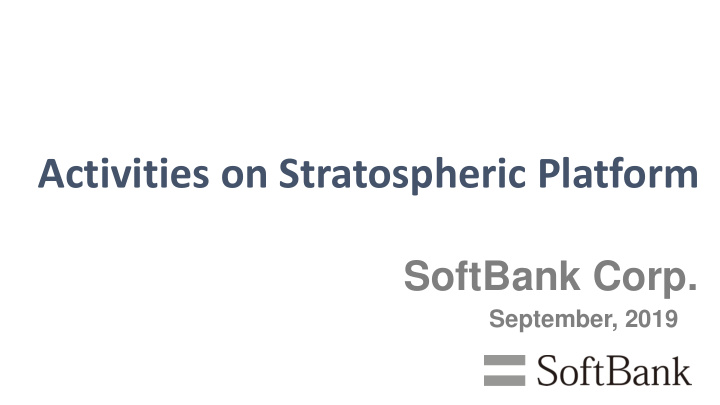



Activities on Stratospheric Platform SoftBank Corp. September, 2019
Disclaimer This presentation material is made based on information available at the time of writing. Plans, forecasts, strategies, and other forward-looking statements in this presentation are not historical facts, and include elements of risk and uncertainty. Actual results may therefore differ materially from these forward-looking statements due to changes in the business environment and other factors. 2
Mobile technology evolves every 10 years 4K 8K 4G 3G Movie HD Text Image 2020s 2000s 2010s 3
Picocell Microcell Macrocell Wider Macrocell (tower BS) (indoor BS) (hotspot BS) (rooftop BS) 4
Picocell Microcell Macrocell Wider Macrocell Super Macrocell ( ・・・・ ) (indoor) (hotspot) (rooftop) (tower top) 5
Satellite System in general Stratospheric Platform “Indirect communication via “Direct communication w/o ground- based IMT base stations” ground- based base stations” Ordinary cellphone 6
Usage Scenarios “Towards 5G era” Coverage Enhancement IoT Safety and Security Drones Mobile Communication Anytime, Anywhere 7
Covering image Altitude: 1000 km~ Stratosphere Altitude: 20km Holding around (n)km in diameter Altitude: 10km Maximum to over 200km in diameter Providing coverage in areas where no current terrestrial solution 8
Covering image Supplemental method for incumbent MNOs which might be provided through the stratospheric platform operator Covered area w/terrestrial infrastructure Underserved area w/terrestrial infrastructure Covered area w/stratospheric platform Providing coverage in areas where no current terrestrial solutions 9
Agenda Item 10 New Agenda Item for WRC-23 on HIBS (High Altitude IMT Base Stations) 10
Frequency Usage Fixed or Mobile Satellite Service Feeder Link (Backhaul) Service Link Fixed Service Mobile Service 11
Frequency bands available for Service-Link Existing bands identified for IMT (below 2.7GHz) 1.9/2.1 GHz can only be used for HIBS service-link (RR 5.388A) *No flexibility in use 450M 600M 700M 800/900M 1.5G 1.7G 1.9G 2.1G 2.3G 2.6G Aiming at expansion of available frequency bands *Flexibility in use (Candidate bands are TBD) 450M 600M 700M 800/900M 1.5G 1.7G 1.9G 2.1G 2.3G 2.6G ➔ New agenda item proposal for WRC-23 12
Difference from AI 1.14 “AI1.14 HAPS” “AI10 HIBS” Identification of Authorization of new frequency band new usage in existing IMT frequency band for for Fixed service usage Mobile service usage 13
Status of HIBS proposal in each region Asia-Pacific: Japan proposed in APG19-3 (Mar. 2018) ➔ APT adopted HIBS proposal as “PACP" in APG19 -5 (Jul/Aug. 2019) Americas: Brazil proposed in 34 th CITEL PCC2 (Aug. 2019) ➔ CITEL adopted HIBS proposal as “IAP” with 13 countries supports Africa: SADC & EACO proposed in 3 rd ATU WG (Jun. 2019) ➔ ATU adopted HIBS proposal as “AFCP” in APM19-4 (Aug.2019) 14
Potential Schedule for New Regulations 2019 2020 2021 2022 2023 2024 2025 WRC-19 WRC-23 New Agenda Item Additional Studies in ITU-R (e.g. Sharing and Compatibility) to be adopted Identification Current Regulations New Regulations Over 5 Years from now Essential that WRC-19 adopts a new Agenda Item to allow for timely deployment of HIBS 15
Change the World Your Support is Greatly Appreciated 16
Recommend
More recommend